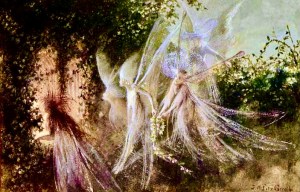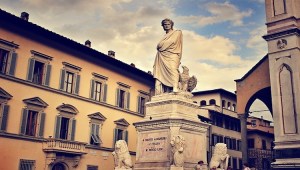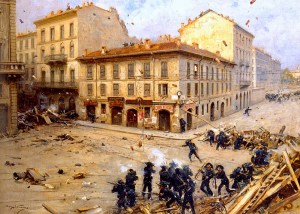We support our Publishers and Content Creators. You can view this story on their website by CLICKING HERE.
C.S. Lewis would most certainly have remembered the interest in fairies from the 1920s, and his fascination with other realms, and with fantasy, myth, legends and folklore would guarantee a continued interest in the possible existence of fairies.
“If you believe in Fairies… clap your hands.” Or so you are encouraged to do when Peter Pan’s friend Tinkerbell dies. J.M Barries’ classic play was written in 1904— which may have primed the pump for an unusual craze: belief in fairies. Fairy mania reached a zenith in 1917 when Frances Griffiths and Elsie Wright, two cousins from Cottingley in Yorkshire, produced photographs of themselves with fairies in their backyard. Sir Arthur Conan Doyle, who nurtured a keen interest in the paranormal, championed the authenticity of the photographs, and by the early 1920s people across England seemed to be clapping their hands for the fairies.
Belief in all sorts of little people was nothing new. There is an interesting passage in the diaries of the Rev. Francis Kilvert, a late Victorian country parson, in which he records a visit to an elderly farm worker in the depths of the Herefordshire countryside. He writes quite openly about the conversation in which the old woman recounted how, as a little girl, she had regularly seen the fairies dancing.
Kilvert was writing in the 1890s about events that would have transpired in the first few decades of the nineteenth century. Kilvert records the conversation without guile—giving the impression that such stories were not uncommon among the rural working classes of the time. Indeed, belief in “the little people” is almost universal across human cultures and times. In Ireland they are the leprechauns, In European folklore they may be called Brownies, Gnomes, Goblins or Pixies. Most primitive cultures have tales of miniature humanoids, and like other indigenous cultures, Native American Tribes have their own names for the little people.
The photographs of the Cottingley fairies were eventually de-bunked by magician and paranormal skeptic James Randi in 1978, and the girls (by then old ladies) admitted to their mischief about ten years later. Despite admitting to having faked the photos, however, Elsie and Frances insisted that they had indeed seen fairies and that the fifth and final photograph was real.
C.S. Lewis would most certainly have remembered the interest in fairies from the 1920s, and his fascination with other realms, and with fantasy, myth, legends and folklore would guarantee a continued interest in the possible existence of fairies. I have been unable to trace any clues that Lewis knew of Kilvert and his diaries, but he certainly knew of that earlier kindred spirit: Herefordshire parson Thomas Traherne, Lewis hiked with Tolkien across the hills of Herefordshire where Kilvert ministered, so he may also have stumbled across similar folktales from the region.
 Lewis treats the subject of fairies in the sixth chapter of his final book The Discarded Image. The book is a detailed description of the cosmology of the medieval period and, as such, is also an extraordinary display of Lewis’ vast erudition. After explaining the medieval understanding of the heavens and planetary systems, Lewis turns to what he calls the Longaevi. He avoids the term “fairies” because it is “tarnished by pantomime and bad children’s books with worse illustrations.” (Probably referring to Barrie’s popular play and Princess Mary’s Gift Book—the book from which Elsie and Frances clipped the pictures they used in their fake photos.)
Lewis treats the subject of fairies in the sixth chapter of his final book The Discarded Image. The book is a detailed description of the cosmology of the medieval period and, as such, is also an extraordinary display of Lewis’ vast erudition. After explaining the medieval understanding of the heavens and planetary systems, Lewis turns to what he calls the Longaevi. He avoids the term “fairies” because it is “tarnished by pantomime and bad children’s books with worse illustrations.” (Probably referring to Barrie’s popular play and Princess Mary’s Gift Book—the book from which Elsie and Frances clipped the pictures they used in their fake photos.)
He took the term Longaevi from Martianus Capella (a fifth-century Neoplatonic philosopher), “who mentions ‘dancing companies of Longaevi who haunt woods, glades and groves, and lakes and springs, and brooks; whose names are Pans, Fauns… satyrs, silvans, nymphs.’”
But what are these creatures and in what sense are they “real”? Lewis suggests that the medieval mind understood them to be inhabitants of a kind of middle realm between the physical and the spiritual regions. After perusing the literature on the subject, Lewis outlines four theories about their nature.
First, they are a “third rational species distinct from angels and men.” He quotes a seventeenth-century writer: “Their nature is middle between Heaven and Hell…. They reign in a third kingdom, having no other judgement or doom to expect forever.” Within this category, Lewis discerns from the writers of antiquity four subsets: a) Nymphs, who are spirits of the waters—human in stature and able to speak; b) Sylphi, spirits of the air who are larger than humans and unable to speak: c) Gnomi, of earth, short and taciturn; and d) Salamandrae or Vulcani creatures of the fire. The Nymphs Lewis identifies with Fairies. The Gnomes are closer to dwarves.
Another medieval writer opines that the Longaevi are demoted angels—a band of spirits who did not totally join with Satan’s rebellion, but who were antagonistic to the Almighty’s reign. They were assigned to a middle realm: a kind of half-existence between angels and men to be relegated to the inferno on doomsday. Some dwell in a middle range of the heavens, some in an in-between earthly realm.
A third theory is that the Longaevi are the dead: ghostly spirits. On death it was supposed that those who did not go to heaven or hell may end up in “fair Elfland”—a middle-earth that is populated with the recent dead or some souls who are thought to be dead but who, in fact, were “taken by the fairies.”
The final opinion is that the Longaevi are demons, and this is the prevailing view from the seventeenth century, as the medieval mindset gave way to the onslaught of both the Protestant Reformation and the subsequent rationalism of the Enlightenment.
Curiously, Lewis’ chapter on the medieval theories about the Longaevi connects with the modern theories on the paranormal by British writer Patrick Harpur. In his book Daemonic Reality, Harpur explores not only the legends of fairies and little people, but also the range of paranormal experiences: encounters with aliens, cryptids, ghosts, and monsters.
Harpur also proposes the existence of a middle realm between earth and heaven. He suggests that the beings that populate this realm are indeed “real” but not real in a scientifically verifiable way. Instead they manifest to the human senses and may even leave traces in the physical realm: a scorch mark from a UFO; a footprint of Bigfoot; a little jacket from a leprechaun. But such beings will never be captured, analyzed, or put in a zoo or museum. According to Harpur, this is because they are creations of the human mind—manifestations of the collective unconscious.
Be that as it may, Lewis concludes his outline of the medieval theories about fairies: “Such were the efforts to find a socket into which the Fairies would fit. No agreement was achieved. As long as the Fairies remained at all they remained elusive.”
In other words, “If you believe in fairies, clap your hands.”
The Imaginative Conservative applies the principle of appreciation to the discussion of culture and politics—we approach dialogue with magnanimity rather than with mere civility. Will you help us remain a refreshing oasis in the increasingly contentious arena of modern discourse? Please consider donating now.
The featured image is “Fairies Looking Through A Gothic Arch” (c. 1864), and is in the public domain, courtesy of Wikimedia Commons. The photograph of the Cottingley Fairies was taken in 1917, and first published in 1920 in The Strand Magazine, and is in the public domain, courtesy of Wikimedia Commons.
Share This Story, Choose Your Platform!
Go to Top

 Conservative
Conservative  Search
Search Trending
Trending Current News
Current News 






